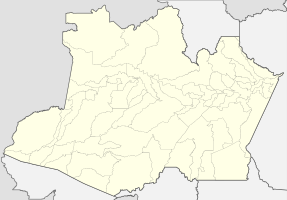Central Amazonian Conservation Complex
|
Central Amazonian Conservation Complex
IUCN category not listed - |
||
|
Land-water mosaic of the eastern part of the Anavilhanas National Park |
||
| location | Northwest of Brazil | |
| surface | 52,320.18 km² | |
| WDPA ID | 220296 | |
| Geographical location | 2 ° 12 ′ S , 62 ° 30 ′ W | |
|
|
||
| Sea level | from 50 m to 80 m ( ø 65 m) | |
| Setup date | December 2, 2000 | |
The Central Amazon Nature Conservation Complex , officially Portuguese Complexo de Conservação da Amazônia Central , is a UNESCO World Heritage Site in Brazil , which was founded in 2000 as an extension of the Jaú National Park . In 2003 it was expanded to include three additional areas. It is one of the largest nature reserves in the Amazon basin and covers an area of 52,320 km² of largely untouched tropical wilderness . The protected area is characterized by a very high biological diversity . The area is located mainly at the confluence of the Negro - and Solimões - Amazonas .
Flora and fauna
The conservation complex contains most of the ecosystems recorded in the Amazon , including tropical rainforests , annually flooded Várzea floodplain systems, Igapó forests , lakes and natural channels that together form an ever-evolving aquatic mosaic.
The protected area consists of two separate areas. The smaller area to the east - Anavilhanas Archipelago - is one of the largest river archipelagos in the world and is constantly changing. It is home to the largest population of the electric eel Electrophorus varii . The site protects a great diversity of species , including rare and endangered species such as the arapaima (the largest freshwater fish in South America), the Amazon manatee , the black caiman , as well as the Amazon dolphin and the Amazon sotalia .
A total of 120 species of mammals, 15 species of reptiles, 411 species of birds and 320 species of fish can be found in this protected area. That is 60% of the fish species that live in the Negro River catchment area and 60% of the birds registered in the central Amazon region. Among the mammals, the giant otter , the jaguar and some endangered primates such as the red uakari and the dark squirrel monkey should be mentioned. Central Amazonia is also a center of plant diversity and is characterized by a high number of endemic species.
population
Several thousand people live within the boundaries of the area, according to a group of the indigenous people of the Miranhas in the Cuiú-Cuiú Indian reservation. All inhabitants of the region live from subsistence farming and are therefore dependent on intact ecosystems . So far, however, they have not been involved in planning or managing the protected area.
Individual evidence
- Central Amazon Conservation Complex unesco.org




